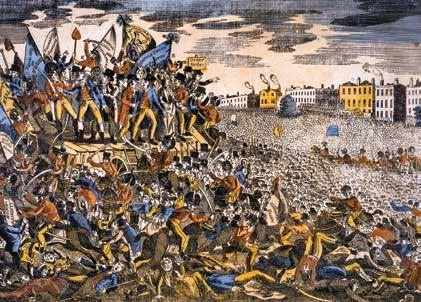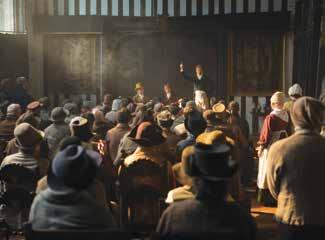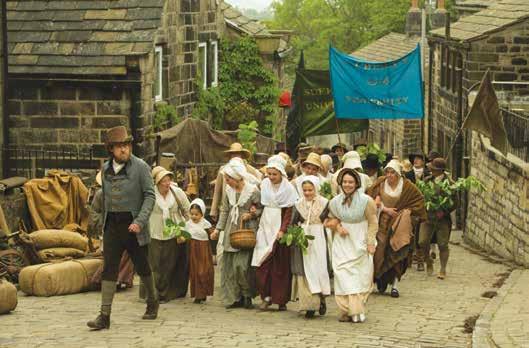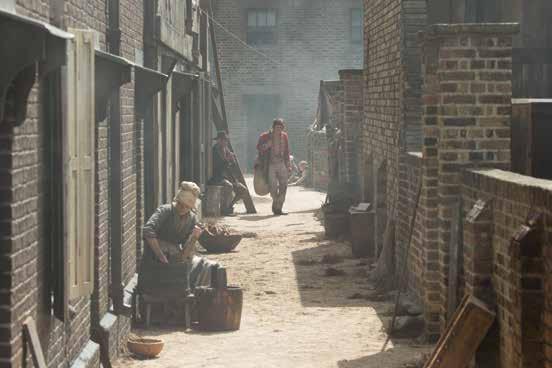
12 minute read
PETERLOO FROM PAGE TO SCREEN
Jacqueline Riding looks back at her experience as historical adviser to Mike Leigh on his film about the Peterloo Massacre, the 200th anniversary of which has been marked this year
I began working with Mike Leigh in 2011 after responding to a job advertisement in the Guardian for an experienced researcher and specialist in British art. The film, at that stage referred to as ‘Untitled 13’, was released in 2014 as Mr. Turner. I soon discovered that the historian working on a Mike Leigh movie was required to advise on and provide detail about an extraordinary breadth of subject matter.
For Mr. Turner my work covered every aspect of the artist’s life and, more broadly, his times, from the physical appearance of the Royal Academy of Art’s Annual Exhibition and, specifically, the exhibits in 1832, 1845 and 1850 (covering the three sequences seen in the film), to early nineteenth-century housekeeping and cookery, including recipes involving a pig’s head, and the contents of a physician’s medical bag in the 1830s and 1840s. The role involved working very closely with Mike himself – being his ‘extra brain’, as he described it – as well as with the producers, assistant directors, departments covering costume, make-up and hair, production design, and alongside the cast, whether in groups (by character type, ‘artist’, for example) or individually.
Given the sheer scale and variety of information needed, I turned to The London Library. I had experienced the huge benefits of membership when I was assistant curator at the Palace of Westminster in the 1990s, and I continued to consult the collections throughout the two-year period from pre- to post-production. Coupled with the ability to take books home and the range of online resources (including the Burney Collection of seventeenth- and eighteenth-century newspapers, 19th-Century British Library Newspapers and the Times Digital Archive 1785–2010, which are, for me, invaluable), browsing the open shelves provided many discoveries – and distractions – on the way.
When Mike announced at the end of 2014 that the focus of his next project was the Peterloo Massacre, an event which, historically, occurred just before the opening scene of Mr. Turner, I returned to the Library. Here I can only offer a hint as to the diversity of the research covered for this film, which then underpinned my accompanying narrative history, published in 2018 as Peterloo: The Story of the Manchester Massacre, and the richness of the Library’s collections on the topic. But before I continue on the research, I will set out briefly the events in Manchester on 16 August 1819.
On that day, at an area of open ground known as St Peter’s Field, local yeomanry cavalry – an amateur citizen regiment who were, from the evidence of most eyewitnesses, desperately ill prepared, some drunk – supported by British-army regulars, including the 15th Hussars, tore through a pro-democracy meeting of 60,000 people. At that time around 2 per cent of the United Kingdom’s population could vote and Manchester had no Member of Parliament (the entire county of Lancashire had only two MPs), so they had gathered to demand universal male suffrage and equal representation in Parliament. The event itself lasted less than half an hour, but in that short time at least 15 of the people present, including an infant and 2 women, were killed or died later from their injuries, and over 650 were beaten, sabred and maimed. This was the British state, only four years after the defeat of the ‘tyrant’ Napoleon Bonaparte at Waterloo, turning its forces against the people – artisans,
tradesmen, women, children – as they peaceably exercised their time-honoured right to demonstrate. For the authorities charged with keeping the King’s Peace, whether the Home Office in Whitehall or local magistrates, such a vast gathering (the equivalent of half the total population of Manchester at the time) appeared to signal imminent revolution. They had some justification to be wary, given, for the region, the unprecedented scale of the event, and were expected by the government to prepare for any acts of sedition, violence or riot, including calling on the military to assist the civil powers. But the response on the day was (to put it mildly) ham-fisted and, as no illegality was displayed by the organisers, speakers or crowd, totally unwarranted.
Opinions today differ regarding the long-term historical significance of the Peterloo Massacre. Dominic Sandbrook, writing in the Sunday Times (14 October 2018), considered the story ‘fascinating and moving’ but ultimately judged the events, in the greater scheme of things, as ‘a pin prick’. By contrast Tristram Hunt believed it to be ‘one of the defining moments’ of modern Britain, a sentiment echoed by Professor John Bew, who characterises it as one of the ‘greatest scandals’ in the political history of the nation. The subsequent clampdown, with the introduction of draconian parliamentary legislation, against such meetings and against the radical press which had encouraged the mobilisation of people across the country, was devastating to the cause for reform of Parliament in the short term. Yet if one battle for reform and parliamentary representation was lost on St Peter’s Field, ultimately the reformers and radicals won the war, as history reveals.
Bringing this extraordinarily rich and pertinent story to the screen, specifically the lead-up to the event and the massacre itself, was a daunting prospect. It encompasses local, regional, national and international history; the function and personnel of the Home Office and the magistracy; royalty, government and Parliament; the military – professional and amateur – the Industrial Revolution (or revolutions) and the living conditions and experiences of the urban and rural labouring class; folk music, culture and traditions; the religion of the state and nonconformity; education and literature; the reform movement, including female participation; the press and political publications, and much more. The Library’s extensive and diverse collections were essential. A basic search of the Library holdings revealed most if not all of the core texts published on the subject, from R.J. White’s Waterloo to Peterloo (1957) and Donald Read’s Peterloo: The ‘Massacre’ and its Background (1958) to E.P. Thompson’s ground-breaking The Making of the English Working Class (1963) and Robert Reid’s eminently readable The Peterloo Massacre (1989). The famous, or infamous (depending on your view), Peterloo: The Case Reopened (1969) by Robert Walmsley, an attempt to exonerate his relative William Hulton, the chairman of the assembled magistrates who ordered the troops on to the field, is also in the collection. The fact that no narrative

Opposite An engraving depicting the forcible dispersal of the reform meeting in St Peter’s Field, Manchester, 16 August 1819. Published 27 August 1819 by J. Evans and Sons, West Smithfield, London. Image © Alamy Stock Photos. Above Still from Mike Leigh’s film Peterloo, released in 2018, showing Samuel Bamford, played by Neil Bell, and the Middleton Marchers. All film stills in this article, Simon Mein © Thin Man Films. Left Henry Hunt, played by Rory Kinnear, speaking to Hampden Club reformers.

history had been published since 1989 covering the whole subject, aimed at the general reader and integrating the gamut of eye-witness accounts and archival material alongside the fresh scholarship and new perspectives which had arisen over the subsequent decades, was surprising – it was an obvious gap that demanded to be filled.
For military history, particularly looking for information on the 15th Hussars and the Yeomanry Cavalry, I scoured the H. Army, English and H. Reg. Hist. shelves, alighting on John Mollo’s Waterloo Uniforms: I: British Cavalry (1973) and Frederick Leary’s The Earl of Chester’s Regiment of Yeomanry Cavalry: Its Formation and Services, 1797–1897 (1898). For the customs of Lancashire,
including the community parades known as ‘rush bearings’ which influenced the behaviour of the marchers who, from far beyond Manchester, converged on St Peter’s Field, I browsed the S. Folklore &c. section. There I discovered the brilliant work of John Harland and Thomas Turner Wilkinson, including their Lancashire Legends, Tradition, Pageants, Sports (1882). The Biography shelfmark proved vital for key publications on some of the high-profile protagonists. The former Speaker, Prime Minister and in 1819 Home Secretary, Lord Sidmouth, played in the film by Karl Johnson, is described in Philip Ziegler’s Addington: A Life of Henry Addington, First Viscount Sidmouth (1965). The life of the famous radical Henry Hunt, who was the great attraction on the day, played by Rory Kinnear, is recounted in John Belchem’s ‘Orator’ Hunt: Henry Hunt and English Working-Class Radicalism (1985) and in Memoirs of Henry Hunt (3 vols., 1820), penned in his prison cell. The Middleton silk weaver, poet and ardent reformer Samuel Bamford, played by Neil Bell, wrote a wonderfully rich and informative autobiography, Passages of the Life of a Radical (1844).
On the subject of the female reformers, who publicly supported the demand for universal male suffrage, gaining notoriety and abuse in newspapers and satirical engravings as a result, Anna Clark’s The Struggle for the Breeches: Gender and the Making of the British Working Class (1997) in H. England, Social &c. presented an excellent overview. The Manchester Man (1876), the novel by Mrs G. Linnaeus Banks (also known as Isabella Banks), is the source (in an endnote) of what happened to the most prominent woman on the day, the President of the Manchester Female Reform Society, Mary Fildes (played by Dorothy Duffy), who was standing on the hustings, alongside Henry Hunt, when it was attacked by the yeomanry cavalry: ‘Mrs. Fildes, hanging suspended by a nail in the platform which had caught her white dress, was slashed across her exposed body by one of the brave cavalry.’
In order to bring Regency, and specifically post-Waterloo, Manchester to life, a perusal of the shelves in the sections T. England, S. Industries and S. Cotton revealed some gems, including A Picture of Manchester (1816; the Library also has a third edition of c.1826), a contemporary guide to the town and its sister township of Salford by local lad, journalist and playwright Joseph Aston (1762–1844). His pithy descriptions of the key cultural, charitable, legal and governmental institutions and buildings provide a wonderful snapshot of a town in transformation. Using the 1816 edition was particularly important, as central Manchester underwent significant change in the 1820s, including street widening, demolition and major building work. At the time of the massacre, St Peter’s Field, on the southern edge of the town, was in the process of being cleared for new streets and residences, including Lower Mount Street (where the magistrates watched as the terrible events played out), Windmill Street and Peter Street. As described by Aston in 1816, Manchester was an interesting mix of medieval and Tudor buildings, with elegant modern Georgian additions. Aston’s maps and vignette illustrations were immediately sent to the production designer, Suzie Davies, and her team. Additional information was gleaned from John Aikin’s A Description of the Country from Thirty and Forty Miles Round Manchester (1795).
Using such literary resources, alongside the superb visual material at Chetham’s Library in Manchester, the production design team and location managers were armed to scout for suitable locations. In the event, not one second of film was shot in Manchester itself, as a great Victorian and modern city has emerged since the massacre, yet – although the Midland Hotel and the Free Trade Hall (also, now, a hotel)

Left Film still showing workers’ housing in Ancoats. Opposite The labouringclass radical John Johnston, played by Johnny Byrom, addresses a political meeting on the moors.
occupy the site of St Peter’s Field – the street plan would still be familiar to Aston and his contemporaries. Instead, with the skill of Suzie and her team, central Chester and Lincoln, the magnificent Old Hall at Gainsborough and the Historic Dockyard at Chatham were transformed into early nineteenth-century Manchester, and Tilbury Fort in Essex was used for St Peter’s Field itself. Regarding the latter, additional façades were built around the parade ground and CGI did the rest.
But this was only part of the story. Manchester (and more broadly Lancashire) was also the centre of textile production and by 1819, in areas of the city such as Ancoats and New Islington to the north, the modern age in the form of the industrial revolutions had already transformed the townscape, with multi-storey factories and streets of terraced back-to-back workers’ housing rising at an astonishing rate. For this subject I turned to the sections S. Industries, S. Cotton and, again, Biography, and publications such as R.S. Fitton and A.P. Wadsworth’s The Strutts and the Arkwrights, 1758–1830: A Study of the Early Factory System (1958); C.H. Lee’s A Cotton Enterprise, 1795–1840: A History of M’Connel & Kennedy, Fine Cotton Spinners (1972); and the translated journal of the Swiss engineer and industrialist J.C. Fischer in J.C. Fischer and his Diary of Industrial England 1814–51, edited by William Otto Henderson (1966). Fischer hints at the social impact the new technology had had on the handloom weavers and spinners of Lancashire, who were to come in their droves on 16 August 1819, in his comment: ‘when one sees these power looms for oneself it is easy to appreciate the bitter feelings of the men who have been thrown out of work [by them]. Fifty of these looms – operated by one and the same steam engine – stood in a medium-sized room. Each was no more than about 4 feet in height, length and width. They were operated by 15 artisans and one foreman.’
Peterloo is demonstrably an important milestone on the journey to democracy in the UK, yet it is a piece of the nation’s history which, at best, has been studied ad hoc across the country, and the majority of British citizens, who have benefited from the determination and sacrifice of their forebears, knowing little or nothing about it. Worse still, judging from recent election turn-out, the right to vote and achieving equal representation in Parliament are sadly undervalued by a significant proportion of the electorate. Peterloo received its UK premiere in Manchester in October 2018, and although in itself the film cannot be expected to raise participation in general and local elections, if nothing else it heralded the imminent arrival of the 200th anniversary. Nearly a year on from its release, we can say that cinema-goers and online viewers, at home and across the world, are much better informed about why and how we in the UK possess the rights that we do. With the bicentenary commemoration in full stride, involving events organised across the country throughout 2019 but with the focus, rightly, on Manchester and England’s north-west, now even more of us are wiser still. Through my research undertaken for the film and accompanying book, the Library has played an important part in helping to bring this crucial story back into national prominence. .








